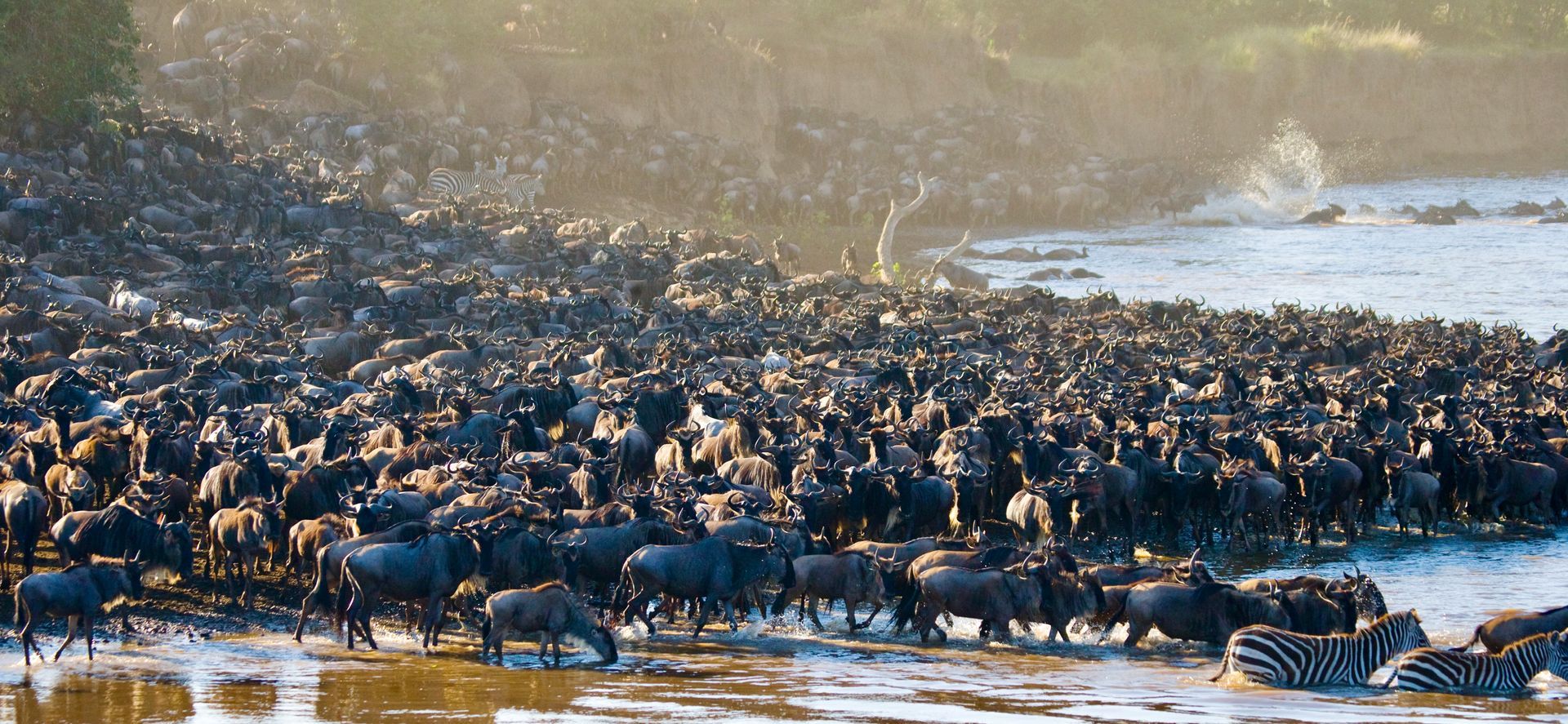THE ULTIMATE MIGRATION GUIDE
Navigate the Great Wildebeest Migration
Undoubtedly one of the world's natural wonders, Africa’s Great Migration offers a wildlife spectacle beyond what words or photos can capture. Central to this 2,000-kilometre journey are the wildebeest—around 1.5 million of them—alongside gazelles and zebras as they traverse the plains of eastern Africa. This is the largest land mammal migration on Earth. This breathtaking event spans the Serengeti National Park in Tanzania and Kenya’s Masai Mara. Imagine vast herds crossing dusty plains and predator-filled rivers. If this is on your bucket list, here's what you need to know.
Where to go
The majority of the dramatic, breathtaking wildebeest migration takes place in the Serengeti. From January to March, they are found in the southern Serengeti, migrating to the central area by April and May. They move north and west in June and July, crossing into Kenya’s Masai Mara from August to October. By November and December, they return to the Serengeti, repeating this annual cycle.
The Serengeti
Famed for its rich biodiversity, the Serengeti spans over 9,000 square kilometres of grassland, woodlands, forests, and savannah. As a significant driver of Tanzanian tourism, it attracts visitors to the northern safari circuit, including Lake Manyara, Arusha, Tarangire National Parks, and the Ngorongoro Conservation Area.
The park is part of a vast ecosystem, bordered by Kenya's Masai Mara, the Ngorongoro Conservation Area, and various game reserves. Divided into five regions—Serengeti plains, Western Corridor, Northern, Central (Seronera), and Southern Serengeti—it provides diverse and exciting wildlife experiences.
The “Big Five” animals (lion, African bush elephant, black rhinoceros, leopard, and buffalo) can be found, alongside cheetahs, hyenas, and many more. The park is home to over 500 bird species, as well as reptiles like Nile crocodiles and black mambas.
The Western Corridor
From April to June, vast herds of wildebeest, zebras, and gazelles congregate around the Grumeti River in the Western Corridor. This area, fed by the Grumeti and Mbalageti rivers, supports year-round wildlife, including a non-migratory population of wildebeest. The rivers provide essential resources, particularly during dry periods, drawing buffaloes and hippopotami. Predators such as lions, cheetahs, and crocodiles make this region a prime hunting ground.
The Northern Serengeti
From July to November, the Northern Serengeti sees migrating herds navigating the perilous Mara River crossing into Kenya's Masai Mara. This remote, lesser-visited region offers stunning landscapes and abundant wildlife, including lions, elephants, and the rare oribi antelope. It’s quieter than the southern and central regions due to longer travel times but rewards visitors with incredible views.
The Central Serengeti (Seronera)
Seronera, in the central Serengeti, hosts abundant wildlife year-round thanks to its varied ecosystems. Visitors can experience grasslands, acacia and baobab forests, and riverine areas. The Seronera River supports one of the highest concentrations of predators, including leopards. This region is ideal for those seeking to witness the Great Migration, particularly in April and November. Activities include the famous hot air balloon flights offering a unique perspective of the landscape.
The Southern Serengeti
The southern Serengeti’s vast short-grass plains are the source of the park's name, “Serengeti,” meaning “endless plains” in the Maasai language. This region stretches to the Ngorongoro Conservation Area and is known for exceptional game viewing from December to March. During this time, the Great Migration congregates around Lake Ndutu for the calving season, when thousands of wildebeest calves are born, attracting predators like lions and cheetahs.
The Masai Mara National Reserve
Kenya’s Masai Mara National Reserve plays a vital role in the Great Migration, with wildebeest arriving around July to cross the Mara River. This crossing, fraught with dangers from crocodiles and the turbulent waters, draws crowds of tourists. The best time to witness this spectacle is from July to October, when the dried vegetation and waterholes make animals more visible. The herd returns to the Serengeti by November, continuing the migration cycle.
Proper planning is key
The Great Migration is a once-in-a-lifetime experience, best viewed from a jeep or hot air balloon. Numerous tour packages are available, from lodges to mobile camps. Booking your safari 8-12 months in advance is advised to secure accommodation. Essentials include binoculars, cameras, walking boots, sunscreen, and warm clothing for early morning and evening drives.
Feel free to get in touch to find out more!







